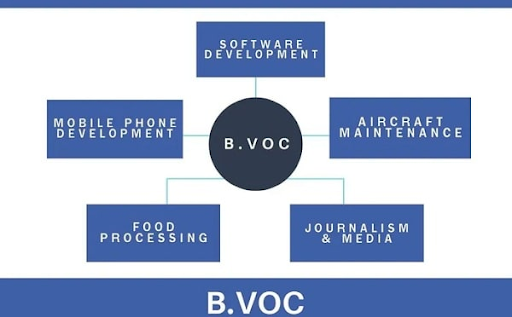Interior design is a fascinating field that bridges the gap between creativity and functionality. It’s the art and science of creating environments that not only look aesthetically pleasing but also serve a purpose. The Bachelor of Vocation (B.Voc) program in Interior Design delves deep into this dynamic domain, equipping students with the skills to craft spaces that leave a lasting impact. In this blog post, we’ll explore the core subjects that form the foundation of B.Voc Interior Design, combining artistic flair with scientific principles.

Design Principles: The Bedrock of Creativity
Design principles serve as the cornerstone of any interior design endeavor. Students in the B.Voc program learn about balance, unity, contrast, rhythm, and harmony, enabling them to create spaces that are visually appealing and functional. Understanding the interplay of these principles is crucial to ensuring that a room is not only beautiful but also coherent and comfortable.
Architectural History: Drawing from the Past
Studying architectural history allows interior design students to draw inspiration from different time periods and styles. By understanding the evolution of architecture and design, students can incorporate elements from various eras into their projects. This knowledge adds depth and richness to their creative repertoire, enabling them to cater to diverse design preferences.
Material Science: The Fusion of Aesthetics and Functionality
Interior designers must choose materials that not only look good but also stand the test of time. B.Voc students delve into material science to learn about the properties, durability, and sustainability of various materials. This knowledge empowers them to make informed decisions when selecting materials for furniture, flooring, lighting, and more.
Spatial Planning: Crafting Functional Layouts
Spatial planning is the art of arranging furniture and components within a space to maximize functionality and flow. B.Voc Interior Design students gain expertise in understanding the needs of clients and translating them into efficient and ergonomic layouts. This subject teaches them to create spaces that are not only beautiful but also highly functional.

Color Theory: Mastering the Palette
Colors have a profound impact on the mood and ambiance of a room. B.Voc students explore color theory, learning about color combinations, contrasts, and psychological effects. This knowledge enables them to select the right color palettes for different spaces, creating atmospheres that resonate with the intended emotions.
Computer-Aided Design (CAD): Where Art Meets Technology
In the modern era, technology plays a pivotal role in interior design. B.Voc students receive training in CAD software, allowing them to create detailed and precise design plans. This fusion of artistic vision and technological prowess equips them to visualize concepts in a digital format and communicate their ideas effectively with clients and contractors.
Sustainability and Green Design: Designing for the Future
As environmental concerns become increasingly important, sustainable design practices are gaining prominence. B.Voc Interior Design students learn about eco-friendly materials, energy-efficient designs, and strategies for minimizing a project’s environmental footprint. This subject empowers them to create spaces that are not only visually appealing but also environmentally responsible.

Entrepreneurship and Project Management: Navigating the Business Landscape
Interior design is not only about aesthetics but also about managing projects and running a business. B.Voc students delve into entrepreneurship and project management, learning how to handle budgets, timelines, client communication, and marketing. This well-rounded education ensures that graduates are not only creative designers but also savvy professionals.
Communication Skills: Articulating Design Concepts
Effectively communicating design ideas to clients, collaborators, and contractors is essential. B.Voc students work on their communication skills, learning how to create compelling presentations, articulate their design concepts, and collaborate with different stakeholders. This skill set is invaluable in translating visions into tangible realities.
5 FAQs about B.Voc Interior Design:
- What is the duration of the B.Voc Interior Design program?
The duration of the B.Voc Interior Design program typically ranges from 3 to 4 years, depending on the educational institution and the curriculum structure.
- Can I pursue a B.Voc Interior Design program without a background in design?
Yes, many B.Voc programs in Interior Design accept students from diverse educational backgrounds. While prior design knowledge can be helpful, these programs often start from the basics to build a strong foundation.
- What career opportunities are available after completing B.Voc Interior Design?
Graduates can pursue careers as interior designers, spatial planners, design consultants, furniture designers, or even set up their own design firms. They can also work in industries like real estate, hospitality, retail, and more.
- How does technology factor into B.Voc Interior Design?
Technology, particularly computer-aided design (CAD) software, is integral to modern interior design. B.Voc students receive training in CAD, enabling them to create detailed designs, renderings, and 3D models.
- Is practical experience a part of the B.Voc Interior Design program?
Yes, many B.Voc programs emphasize practical experience through internships, workshops, and real-world projects. These hands-on experiences help students apply theoretical knowledge to actual design challenges.
In conclusion, the B.Voc Interior Design program is a comprehensive journey that amalgamates artistry and scientific principles. By delving into design principles, architectural history, material science, and more, students gain a holistic education that equips them to transform spaces into captivating works of art. Whether you’re an aspiring designer or simply intrigued by the world of interior design, exploring these core subjects provides a glimpse into the multidimensional nature of this creative field.

